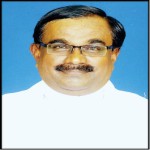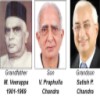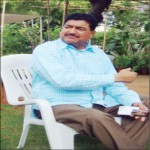Read ‘Outlook’ Advisory of Jan.

The January 12, 2015 issue of ‘Outlook’ magazine, released to market in advance as usual, edited by our Mysuru boy Krishna Prasad had a surprise for me, which may as well be a New Year’s compliment for a humble editor of a local evening English newspaper of 38 years, much older to this young ‘Outlook’ of 20 years.
I find a peculiar trait among newspaper and magazine readers in the way they open them. Those who are sports and games freaks go right away to the sports items that usually are placed in the last pages and if it is an English magazine like ‘Outlook,’ ‘India Today’ or ‘The Week,’ the three Weeklies I read, some start from the backpages where you get tit-bits on fashion, art and culture, book and film reviews. I am one such peculiar fellow. That’s how I happened to read the ‘New Year Diary’ of this ‘Outlook’ which was surprisingly written by its Editor-in-Chief Krishna Prasad, who, as I know, seldom writes.
Since the byline was Krishna Prasad, I right away began to read through and to my utter surprise he had recalled what I had written about one of my meetings with the renowned English novelist R.K. Narayan. I had narrated an incident where Narayan had refused to see a person because he had not taken an appointment for the meeting. However, I have to now complete that incident with an addendum. After all, any writing reveals only half of the story, like nature reveals only half of its mystery. Hence this addendum necessitated by Krishna Prasad’s recall of what I wrote.
As I came down the steps from the upstairs where Narayan lived and worked, the person from Bangalore was still there, probably hoping he would get an audience from that reluctant Narayan after yours truly came out.
“Sir, could I see him now?” he asked me with a poker-face. I know this was the man, Narayan said, had come to represent ‘Gentleman’ magazine. He had practically buttonholed me.
“I don’t think you can. You should have taken an appointment. Moreover, this is an odd hour,” I said forgetting I myself was with him at an odd hour 3 O’ clock if I remember right. But then Narayan had called me on telephone to discuss about the Kukkarahalli Lake which was covered with water hyacinth fed with the sewage water let into it by the callous City Corporation.
“I have come from Bombay. I tried to contact him from Bangalore Airport but could not,” he sounded a much worried man. If he had anytime worked as Avery Salesman, he would have gatecrashed, no matter the consequence. Apparently he had not.
The very reputation of Narayan might have inhibited him from precipitating such a misadventure. I took pity for that hapless, helpless man wondering how he would face his boss back in Bombay. This is one example how journalists, in this case the editor of ‘Gentleman’ magazine, could be presumptuous and this is also one rare example where an interview was refused to one who had travelled a long distance with much expense to discuss a deal that might benefit the interviewee Narayan. But such is life. Fortunately for me he did not ask any help. But I made an unsolicited suggestion. “You have come all the way from Bombay. It’s evening. Why not stay overnight, take an appointment for tomorrow?”
He smiled rather approvingly and walked with me to the gate the gardener kindly opened. I got into my car and left. I saw him getting into his waiting taxi and drive away.
While at the subject of ‘Outlook,’ let me deal with it a little deeper, considering the ‘Double Dhamaka’ of the issue is to celebrate 20 years of ‘Outlook.’ Before ‘Outlook’ came to the market, I was a regular reader of ‘India Today’ which was a fortnightly. With a very good business sense, it became a Weekly on finding a rival in ‘Outlook’ which came out as a Weekly. And over the years, I find both magazines flourishing. While ‘Outlook’ resonates to the left-of-centre ideology, the ‘India Today’ pulsates to right-of-centre ideology. But the good news is that both are well-positioned to scoop the moolah !
Small wonder that for a New Year issue a subject like ‘100 books that can change your life’ is chosen. It is like trying to choose 100 beautiful pebbles from the sea-shore. One is indeed at sea doing this exercise and this is clear from a confessional on Page-67 ‘The Almosts: 50 Not Out’ — Lists are unfair. Think of those that didn’t make it even to this list.
This reminded me of the book I recently read “Leaders Who Changed the World” by Gordon Kerr and another, “The Speeches that Changed the World.”
And to think that books can change my life, or anybody’s life for that matter, is a proposition far removed from the reality. From my experience of the Biblical years of over three scores and ten, I would rather believe in Luck to change my life than books suggested by my good friend Krishna Prasad. Let me explain.
In Mahabharatha there is a story. That is, Kunti’s story of Luck.
Once a child’s naming ceremony was being held in a Pundit’s house. As per tradition all the villagers with their wives were invited. The mother of Pandavas, Kunti, too was invited for the naming ceremony. The tradition was to address the child by name and bless it with a grace word or phrase. Six privileged wives (Muthaides, meaning those with husbands living) would get the first opportunity for this ritual.
The first such woman went to the child, called its name and blessed it saying, “May you be a wealthy man, my child.” The second woman said, “Dear child, it does not matter if you don’t become wealthy, but may you be a learned person.”
The third woman’s turn came and she said, “Child, it does not matter if you don’t become a wealthy man or a learned man, but may you live a healthy man all your life.”
The fourth woman blessed the child saying, “Dear child, no matter you don’t get any of the blessings offered earlier, but may you become a famous man in this world.”
Then the turn of the fifth woman came and she said, “Child, forget about all those blessings offered earlier; may you live a long life in this world.”
Finally, it was the turn of Kunti to bless the child. After the earlier five had blessed with their own wishes, those present wondered what is there left for Kunti to bless the child with. Kunti gently moved towards the child, called it by the name and said, “Don’t worry my dear child if none of the blessings showered on you by those who had earlier blessed you does not happen to you. I bless you to live a life full of luck.”
Hearing this kind of a strange blessing, those present were intrigued. And one woman made bold to ask its meaning. Kunti humbly explained.
“Look, my children, Pandavas, were born to a king. Likewise my sister-in-law Gandhari’s children, too were born to a king who enjoyed the kingdom and every royal comfort. But my children did not have luck. Therefore, till the time Gandhari’s children (Kauravas) died my children could neither enjoy the kingdom nor the royal comfort. Despite having all the warrior qualities like courage, virtue and fighting skills, they spent most of their life in the forest simply because Luck did not favour them. Which is why it is said if a person has luck then everything like wealth, education, health, fame and longevity will come looking for him.”
And finally, speaking for myself, if 33,000 Hindu Gods could not change my life, can these 100 books suggested by ‘Outlook’ do that miracle? But, as Kunti said, Luck will. Lucky and Happy New Year to you Krishna Prasad.
e-mail: kbg@starofmysore.com
source: http://www.starofmysore.com / Star of Mysore / Home> Abracadabra….Abracadabra / Wednesday , January 07th, 2015








